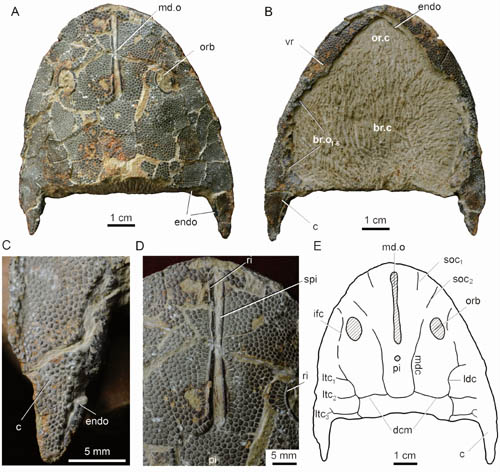In a study published in the latest issue of of Vertebrata PalAsiatic 2012(1), paleontologists from Institute of Vertebrate Paleontology and Paleoanthropology (IVPP), Chinese Academy of Sciences in Beijing reported a new genus and species of the Eugaleaspidiformes (Agnatha: Galeaspida),
Dunyu longiforus gen. et sp. nov., from the Ludlow (Silurian) Kuanti Formation of Qujing, Yunnan, southwestern China, in association with the oldest near-complete gnathostome
Guiyu oneiros of the Xiaoxiang Vertebrate Fauna, providing new thread into this taxonomic puzzle.
The new genus is most suggestive of
Eugaleaspis of the Eugaleaspidae by the absence of inner corners, in addition to the diagnostic features of the family, such as only 3 pairs of lateral transverse canals from lateral dorsal canals, and the U-shaped trajectory of median dorsal canals. They differ in that the new genus possesses a pair of posteriorly extending corners, the breadth/length ratio of the shield smaller than 1.1, and the posterior end of median dorsal opening beyond the posterior margin of orbits.
Dr. ZHU Min, lead author of the study, and his colleagues reexamined the type specimen of
Eugaleaspis xiushanensis from the Wenlock Huixingshao Formation of Chongqing, and observed a pair of posteriorly extending lobate corners and three (instead of four in the original description) pairs of lateral transverse canals. Thus, they re-assigned it to
Dunyu. The new species differs from
Dunyu xiushanensis in its large cephalic shield which is longer than broad, spine-shaped corners, anteriorly positioned orbits, the length ratio between preorbital and postorbital portions of the shield less than 0.75, and large polygonal, flat-topping tubercles exceeding 2.0 mm in length.
“The discovery of the new form from the Xiaoxiang Vertebrate Fauna might provide new thread into this taxonomic puzzle”, said study coauthor LIU Yuhai, an emeritus professor of the IVPP. “In overall, the new form resembles
E. xiushanensis in many aspects, such as the posteriorly extending corner and the breadth/length ratio of cephalic shield less than 1.1. However, compared with
E. xiushanensis, the new form morphologically deviates more from the Devonian
Eugaleaspis species. If we continue to assign this new form to
Eugaleaspis, the diagnosis of the genus has to be further modified to cover a larger morphospace, e.g. the breadth/length ratio of cephalic shield ranging from 0.9 to 1.5.”
“In order to maintain the diagnostic stability of
Eugaleaspis, which is the first genus of the Galeaspida described in the literature, a new genus (
Dunyu gen. nov.) encompassing the new form and
E. xiushanensis is a reasonable treatment. Among the Eugaleaspidae, Dunyu is more closely related to
Eugaleaspis than either to other genera by the absence of inner corners”, said ZHU Min.
This work was supported by Main Direction Program of Knowledge Innovation of Chinese Academy of Sciences and National Natural Science Foundation of China.

